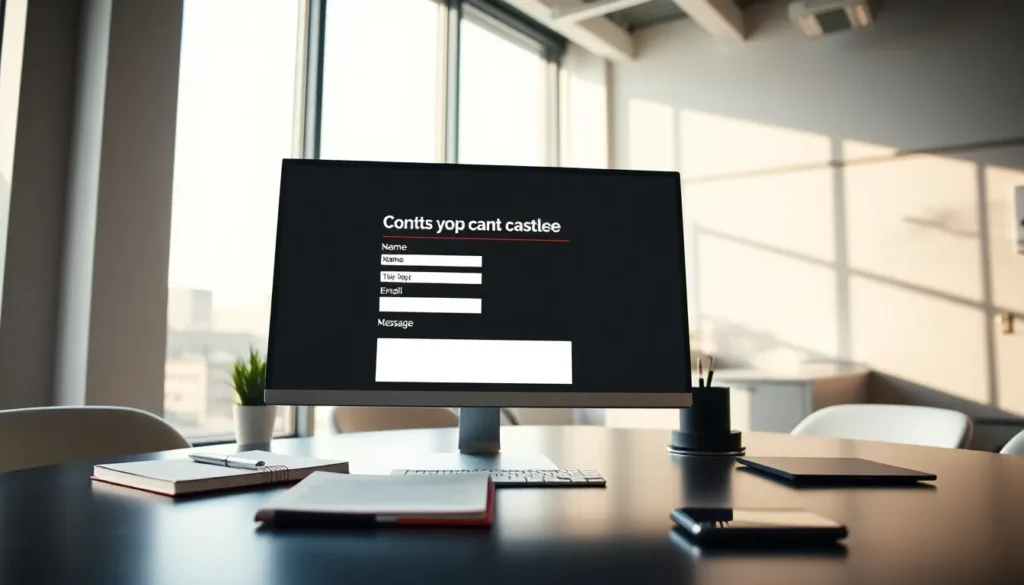Table of Contents
ToggleEver tried reaching out to a website, only to be met with the cold, uninviting void of a poorly designed contact form? It’s a real bummer, isn’t it? A well-crafted contact form is more than just a digital receptionist: it’s your first line of communication, your best chance to connect with customers, gather feedback, and even resolve issues. In this guide, we’ll explore the essential elements that make for an effective contact form, because let’s face it, no one enjoys playing phone tag with an internet connection.
Importance Of A Contact Form For Online Platforms

The importance of a contact form for online platforms cannot be overstated. These forms serve as the gateway for communication between websites and visitors.
- Customer Engagement: A contact form provides an avenue for customers to voice their concerns or inquiries. This allows businesses to demonstrate their responsiveness and support.
- Feedback Collection: By encouraging users to leave feedback, brands can gather valuable insights for improvement. A contact form can, essentially, be a treasure trove of customer opinions and suggestions.
- Lead Generation: Businesses often use contact forms to gather leads. The data captured can then be converted into potential customers. Not to mention it allows companies to grow their email lists effectively.
- Brand Credibility: A clear, easily accessible contact form enhances trust. When customers can easily find a method to reach out, their confidence in the brand generally increases.
Essential Elements of An Effective Contact Form
Creating a standout contact form involves careful consideration of its elements. Here are essential components every effective contact form should have:
- User-Friendly Design: Keep it clean and simple. Avoid clutter. A minimalistic approach helps users navigate effortlessly.
- Required Fields: Not all fields should be mandatory. Focus on the essentials, name, email, and message. Make it easy for users to reach out without overwhelming them with too many requests.
- Clear Labels and Instructions: Each field should be clearly labeled. Provide instructions if necessary. This prevents user confusion and ensures a smoother experience.
- Confirmation Message: After submission, users should receive a clear confirmation message. This assures them that their message has been received, reducing anxiety.
Best Practices For Designing Your Contact Form
To use design as a tool of communication, consider the following best practices:
- Responsive Design: Ensure your contact form looks great on all devices, desktop, tablet, or mobile. A user’s experience should be consistent, regardless of the screen size.
- Visual Appeal: Use contrasting colors for background and text to improve readability. A visually appealing form encourages users to fill it out.
- Auto-Completion: Enable auto-completion features if possible. Users appreciate the convenience of having their information filled out automatically, reducing effort.
- Error Handling: Carry out immediate, constructive feedback for errors. If a user misses a required field, they should know immediately. A simple highlight can save time and frustration.
Common Issues With Contact Forms And How To Troubleshoot Them
Even the best-designed contact forms can face hurdles. Here are common issues that may arise and strategies for troubleshooting:
- Submission Errors: Sometimes, messages just don’t go through. Ensure server issues are not causing these problems. Regularly test the form to confirm smooth functionality.
- Spam Submissions: Spam can clog up your inbox and obscure real inquiries. Use CAPTCHA or honeypot techniques to filter out spam bots.
- Field Validation: If users receive vague error messages, they might abandon the form. Clearly indicate what went wrong and give simple solutions.
- Missing Notifications: Ensure your notification system is robust. If you’re not receiving messages, check email routing and settings.
Integrating Contact Forms With CRM Systems
Integrating contact forms with Customer Relationship Management (CRM) systems can exponentially enhance efficiency. Here’s how it helps:
- Automated Data Entry: Connecting your form to a CRM automates data capture, meaning less manual input and fewer errors.
- Tracking & Friendliness: Monitor interactions and follower progress via the CRM. Having all data in one place allows for tailored communication based on the user’s history.
- Follow-Ups: Use the CRM for follow-up reminders or outreach based on the information gathered from the contact form.
Enhancing User Experience Through Contact Forms
A great contact form doesn’t just gather queries: it can elevate the overall user experience. Here are ways to enhance that experience:
- Personalization: Use personal touches, like addressing users by name in confirmation messages. This small detail can leave a lasting impression.
- Visual Feedback: Carry out visual elements, like changes in color or icons, when a user interacts with the form. This represents responsiveness and can keep visitors engaged.
- Multichannel Options: Consider offering different means of communication, like live chat or social media links. A multi-option approach caters to varied preferences.




